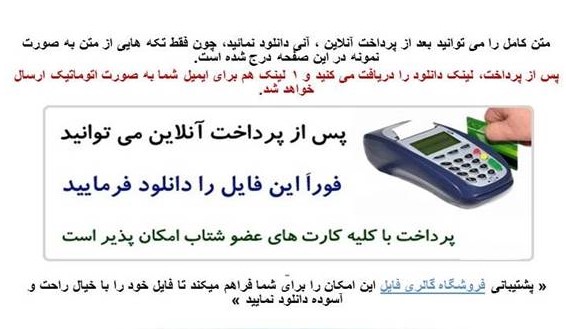لینک دانلود و خرید پایین توضیحات
فرمت فایل word و قابل ویرایش و پرینت
تعداد صفحات: 4
Gingiva
.
Contents
[hide]
1 General Description
2 Subdivisions of Gingiva
2.1 Marginal Gingiva
2.2 Attached Gingiva
2.3 Interdental Gingiva
3 Diseases of the Gingiva
4 Characteristics of Healthy Gingiva
4.1 Color
4.2 Contour
4.3 Texture
4.4 Reaction to Disturbance
5 Additional images
6 See also
7 Sources
8 External links
General Description
Gingiva are part of the soft tissue lining of the mouth. They surround the teeth and provide a seal around them. Compared with the soft tissue linings of the lips and cheeks, most of the gingiva are tightly bound to the underlying bone and are designed to resist the friction of food passing over them. Healthy gingiva is usually coral pink, but may contain physiologic pigmentation. Changes in color, particularly increased redness, together with edema and an increased tendency to bleed, suggest an inflammation that is possibly due to the accumulation of bacterial plaque.
A diagram of the periodontium. A, crown of the tooth, covered by enamel. B, root of the tooth, covered by cementum. C, alveolar bone. D, subepithelial connective tissue. E, oral epithelium. F, free gingival margin. G, gingival sulcus. H, principle gingival fibers. I, alveolar crest fibers of the PDL. J, horizontal fibers of the PDL. K, oblique fibers of the PDL.
Subdivisions of Gingiva
The gingiva is divided anatomically into marginal, attached and interdental areas.
Marginal Gingiva
The marginal gingiva is the terminal edge of gingiva surrounding the teeth in collar like fashion. In about 50% of individuals, it is demarcated from the adjacent, attached gingiva by a shallow linear depression, the free gingival groove. Usually about 1 mm wide, it forms the soft tissue wall of the gingival sulcus. The marginal gingiva is supported and stabilized by the gingival fibers.
Attached Gingiva
The attached gingiva is continuous with the marginal gingiva. It is firm, resilient, and tightly bound to the underlying periosteum of alveolar bone. The facial aspect of the attached gingiva extends to the relatively loose and movable alveolar mucosa, from which it is demarcated by the mucogingival junction. Attached gingiva may present with surface stippling.
Interdental Gingiva
The interdental gingiva occupies the gingival embrasure, which is the interproximal space beneath the area of tooth contact. The interdental gingiva can be pyramidal or have a "col" shape.
Diseases of the Gingiva
The gingival cavity microecosystem, fueled by food residues and saliva, can support the growth of many microorganisms, of which some can be injurious to health. Improper or insufficient oral hygiene can thus lead to many gingival and periodontal disorders, including gingivitis or pyorrhea, which are major causes for tooth failure. Recent studies have also shown that Anabolic steroids are also closely associated with gingival enlargement requiring a gingivectomy for many cases.[1]
Characteristics of Healthy Gingiva
[Color
Healthy gingiva usually has a color that has been described as "coral pink." Other colors like red, white, and blue can signify inflammation (gingivitis) or pathology. Although the text book color of gingiva is "coral pink", normal racial pigmentation makes the gingiva appear darker. Because the color of gingiva varies due to racial pigmentation, uniformity of color is more important than the underlying color itself.
Contour
Healthy gingiva has a smooth arcuate or scalloped appearance around each tooth. Healthy gingiva fills and fits each interdental space, unlike the swollen gingiva papilla seen in gingivitis or the empty interdental embrasure seen in periodontal disease. Healthy gums hold tight to each tooth in that the gingival surface narrows to a "knife-edge" thins at the free gingival margin. On the other hand, inflamed gums have a "puffy" Texture
Healthy gingiva has a firm texture that is resistant to movement, and the surface texture often exhibits surface stippling. Unhealthy gingiva, on the other hand, is often swollen and mushy.
Reaction to Disturbance
Healthy gums usually have no reaction to normal disturbance such as brushing or periodontal probing. Unhealthy gums on the other hand will show bleeding on probing (BOP) and/or purulent exudate (pus).
Additional images
Mouth (oral cavity)
Mouth
The Gingiva means the gum, which is the area around the root of a tooth. The gingiva is the tough, insoluble protein mucosa (a type of membrane) that surrounds the teeth. It forms a band around each tooth that ranges in width from1 to 9 mm. The gingiva is attached in part to the cementum of the tooth and in part to the alveolar bone. The gingiva is composed of mucosa that is designed for chewing
In light-skinned individuals the gingiva can be readily distinguished from the adjacent dark red alveolar mucosa by its lighter pink color.
In dark-skinned people the gingiva may contain melanin pigment to a greater extent than the nearby alveolar mucosa. This melanin pigment is synthesized in specialized cells and is produced as granules that are stored within the cells that produce melanin. If pigmented gingiva is surgically inspected, it will often heal with little or no pigmentation. Therefore, surgical procedures should be designed so as to preserve the pigmented tissues. Clinicians sometime use the terms free and attached gingiva. Attached gingiva refers to the portion of the gingiva towards the top of the tooth. Free gingiva is firmly bound to the underlying tooth and alveolar bone.
The area of the gingiva near the crown of the tooth (Gingival margin) in young people is more likely to become exposed as a result of tooth eruption.
The gingiva occupies the spaces between teeth. It is composed of a pyramidal papilla in the incisor region. The gingiva is attached to the tooth by an epithelium and by connective tissue fibers at the top.
Problems with the gingiva include the following medical conditions:
Gingivitis Periodontitis Acute Necrotizing Ulcerative Gingivitis Primary Herpetic Gingivostomatitis Gingival Hyperplasia or Enlargement Epulis (Localized gingival enlargement) Gingival Erosions

تحقیق درموردمتن انگلیسی لثه انگلیسی


























